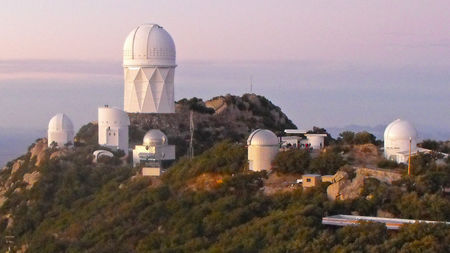US telescopes get a new overseer – Science Magazine

The Kitt Peak National Observatory in Arizona is one of the facilities that will be managed by a new organization created by the National Science Foundation.
Steve (CC BY 2.0)
A new player has joined the leadership of publicly funded astronomy in the United States. Earlier this month, the National Science Foundation (NSF) launched the National Optical-Infrared Astronomy Research Laboratory, henceforth to be known as OIR Lab. The new structure, which will be managed by the Association of Universities for Research in Astronomy (AURA) in Washington, D.C., is intended to bring more cohesion to NSF’s rather fractured astronomical facilities and create a technical powerhouse akin to the European Southern Observatory, headquartered in Garching, Germany.
OIR Lab will manage four existing observatories: Cerro Tololo Inter-American Observatory in Chile, Kitt Peak National Observatory in Arizona, Gemini Observatory with instruments in Hawaii and Chile, and the Large Synoptic Survey Telescope, which is now under construction in Chile. The quartet represents essentially all of NSF’s observatories that operate in the optical and infrared wavelengths, but does not include telescopes that observe the Sun. OIR Lab will also incorporate the Community Science and Data Center in Tucson, Arizona.
OIR Lab will be led by Patrick McCarthy, who was previously vice president of the Giant Magellan Telescope (GMT) project, an effort to build a 25-meter telescope in Chile, and an astronomer at the Carnegie Institution for Science in Washington, D.C. ScienceInsider recently chatted with McCarthy about his new charge. The interview has been edited for clarity and brevity.
Q: Why does U.S. astronomy need a new organization?
A: By bringing all of NSF’s nighttime facilities under one umbrella, we can better leverage scientific synergies, utilize technical expertise to greater effect, and build a solid foundation for future initiatives. We can also better serve the scientific users by removing artificial barriers between cross-platform programs. There has been good progress in this area over the past several years, but the new laboratory structure takes this a step further.
Q: What will be the major gains from having these three previously separate observatories under one umbrella?
A: By more closely coordinating NSF’s optical-infrared astronomical sciences facilities managed by AURA, researchers will benefit from improved access, data sharing, and user support services.
Services, such as [information technology], health and safety, communication, education, community engagement, and facilities operations will be shared across the observatories and projects. Scientists will have an opportunity to support the users of all NSF OIR Lab telescopes and work more closely together by sharing ideas and best practices. Engineers will have more flexibility and new opportunities to work on projects at multiple facilities within the organization. Researchers will see a more common user interface when applying to use any of the lab’s telescopes.
Q: Can you give an example of a project or activity that will be made possible by the greater integration of these telescopes?
A: The clearest early examples will involve time-domain and survey astronomy. With a larger number of telescopes in the mix, we can allocate apertures to specialized roles—for example visible spectroscopy of transients [objects changing rapidly] and infrared photometry of transient sources. We can also have a telescope at one site backstop another in the case of bad weather or provide a longer time sampling for variable objects.
As the 4-meter telescope at Kitt Peak will soon be dedicated to a 5-year program focused on studies of cosmic structure using the Dark Energy Spectroscopic Instrument, other telescopes in the system can replace some of the general purpose access that has been reduced as a result. This ensures that good science programs are not lost as we focus on the big questions.
Q: If this leads to streamlining of operations, will there be financial savings?
A: We expect that, as a whole, NSF’s OIR Lab will be cost-neutral—the goal is to grow our capabilities, not shrink our budget. If we can realize efficiency gains, we have numerous areas that need additional talent and resources.
Q: Is there expected to be a reduction in staff in the combined observatories?
A: No.
Q: The Gemini Observatory has international partners and the LSST is partly funded by the Department of Energy. What will be their relationship with OIR Lab?
A: Gemini’s international participants, through the board of directors, retain their role in strategic planning and scientific direction of Gemini. NSF’s OIR Lab will provide the coordination and expertise necessary to allow Gemini to implement that strategy and science efficiently and effectively.
Q: What role will OIR Lab play in the effort by the two giant telescope projects—the GMT and the Thirty Meter Telescope—to make a joint bid for NSF funding?
A: AURA’s portion of the design and development of the [U.S. Extremely Large Telescope] program, which is managed by OIR Lab’s Community Science and Data Center, will continue uninterrupted.




